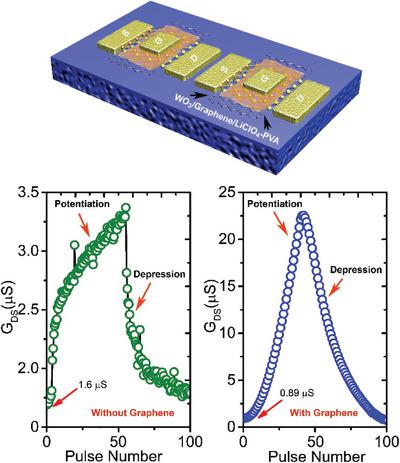当前位置:
X-MOL 学术
›
Adv. Electron. Mater.
›
论文详情
Our official English website, www.x-mol.net, welcomes your
feedback! (Note: you will need to create a separate account there.)
Controlled Ionic Tunneling in Lithium Nanoionic Synaptic Transistor through Atomically Thin Graphene Layer for Neuromorphic Computing
Advanced Electronic Materials ( IF 5.3 ) Pub Date : 2019-12-11 , DOI: 10.1002/aelm.201901100 Revannath Dnyandeo Nikam 1, 2 , Myonghoon Kwak 1, 2 , Jongwon Lee 1, 2 , Krishn Gopal Rajput 1, 2 , Hyunsang Hwang 1, 2
Advanced Electronic Materials ( IF 5.3 ) Pub Date : 2019-12-11 , DOI: 10.1002/aelm.201901100 Revannath Dnyandeo Nikam 1, 2 , Myonghoon Kwak 1, 2 , Jongwon Lee 1, 2 , Krishn Gopal Rajput 1, 2 , Hyunsang Hwang 1, 2
Affiliation

|
Lithium nanoionic transistors have recently emerged as promising artificial synaptic devices for neuromorphic hardware systems. However, mimicking the essential synaptic functionalities including nonvolatile conductance modulation with a near‐linear analog weight update has been a crucial milestone in those synaptic devices and has a direct impact on pattern recognition accuracy. The volatile channel conductance change due to the instability of the solid electrolyte interface and lithium‐ion nucleation at electrolyte‐channel interface are two key phenomena responsible for the nonlinear switching in lithium nanoionics transistor. Graphene is proposed as an atomically thin ionic tunneling layer to establish nonvolatile analog multilevel conduction in lithium nanoionic transistor. The combined effects of controlled ionic tunneling through graphene and stable solid electrolyte interface result in the device exhibiting nearly linear conductance switching with distinct gate‐controllable nonvolatile multilevel conduction states and a smallest asymmetric ratio of 0.26 and highest on/off ratio of 28. A neural network simulation result obtained from the graphene layer device indicates high handwritten digit recognition accuracy. These results demonstrate the potential application of atomically thin two‐dimensional (2D) materials as an ionic tunneling layer in nanoionics synaptic transistors and may facilitate the development of a neuromorphic computing system with high performance.
中文翻译:

锂纳米离子突触晶体管中的可控离子隧穿,通过原子薄的石墨烯层进行神经形态计算
锂纳米离子晶体管近来已成为有希望的用于神经形态硬件系统的人工突触设备。但是,通过近乎线性的模拟权重更新来模仿包括非易失性电导调制在内的基本突触功能,已成为这些突触设备的关键里程碑,并直接影响模式识别的准确性。由于固体电解质界面的不稳定性和电解质通道界面处的锂离子成核,导致挥发性通道电导率变化是造成锂纳米离子晶体管非线性切换的两个关键现象。提出石墨烯作为原子薄的离子隧穿层,以在锂纳米离子晶体管中建立非易失性模拟多级导电。通过石墨烯的受控离子隧穿和稳定的固体电解质界面的综合作用导致该器件表现出几乎线性的电导切换,具有独特的可控栅极的非易失性多级导通状态,最小不对称比为0.26,最高开/关比为28。从石墨烯层设备获得的网络仿真结果表明,手写数字识别精度很高。这些结果证明了原子薄的二维(2D)材料在纳米离子突触晶体管中作为离子隧穿层的潜在应用,并可能促进具有高性能的神经形态计算系统的开发。
更新日期:2020-02-13
中文翻译:

锂纳米离子突触晶体管中的可控离子隧穿,通过原子薄的石墨烯层进行神经形态计算
锂纳米离子晶体管近来已成为有希望的用于神经形态硬件系统的人工突触设备。但是,通过近乎线性的模拟权重更新来模仿包括非易失性电导调制在内的基本突触功能,已成为这些突触设备的关键里程碑,并直接影响模式识别的准确性。由于固体电解质界面的不稳定性和电解质通道界面处的锂离子成核,导致挥发性通道电导率变化是造成锂纳米离子晶体管非线性切换的两个关键现象。提出石墨烯作为原子薄的离子隧穿层,以在锂纳米离子晶体管中建立非易失性模拟多级导电。通过石墨烯的受控离子隧穿和稳定的固体电解质界面的综合作用导致该器件表现出几乎线性的电导切换,具有独特的可控栅极的非易失性多级导通状态,最小不对称比为0.26,最高开/关比为28。从石墨烯层设备获得的网络仿真结果表明,手写数字识别精度很高。这些结果证明了原子薄的二维(2D)材料在纳米离子突触晶体管中作为离子隧穿层的潜在应用,并可能促进具有高性能的神经形态计算系统的开发。











































 京公网安备 11010802027423号
京公网安备 11010802027423号